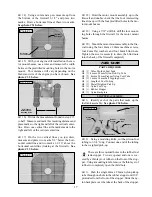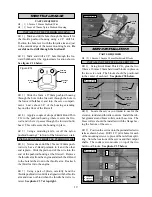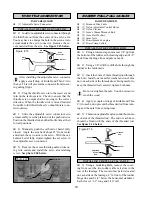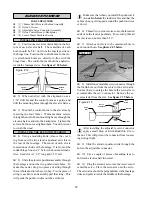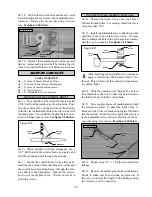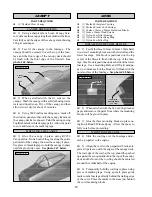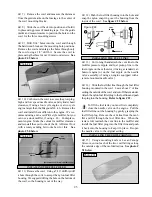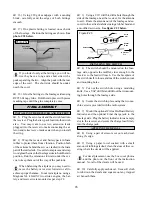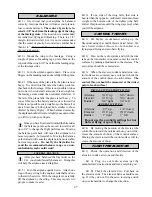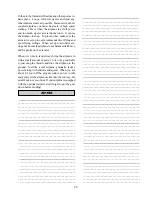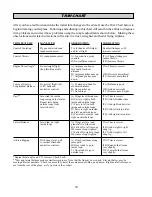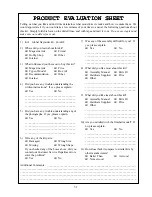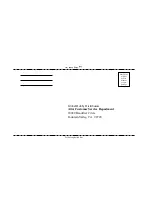
27
After you have balanced the Skyraider on the
C.G. you should laterally balance it. Doing this
will help the airplane track straighter.
q
5) Turn the airplane upside down. Attach one
loop of heavy string to the engine crankshaft and one
to the tail wheel wire. With the wings level, carefully
lift the airplane by the string. This may require two
people to make it easier.
LATERAL BALANCE
INITIAL FLYING/SPORT FLYING
Ailerons:
5/16” up
5/16” down
Elevator:
5/16” up
5/16” down
Rudder:
3/4” right
3/4” left
AEROBATIC FLYING
Ailerons:
1/2” up
1/2” down
Elevator:
9/16” up
9/16” down
Rudder:
1” right
1” left
Do not use the aerobatic settings for ini-
tial test flying or sport flying.
q
4) By moving the position of the clevis at the
control horn toward the outermost hole, you will de-
crease the amount of throw of that control surface.
Moving the clevis toward the control surface will in-
crease the amount of throw.
q
1) It is critical that your airplane be balanced
correctly. Improper balance will cause your plane to
lose control and crash. The center of gravity is lo-
cated 4-3/8” back from the leading edge of the wing,
at the fuselage sides. This location is recommended
for initial test flying and trimming. There is a 3/8”
margin forward and aft, but it is not recommended
that the center of gravity be located any further back
than 4-3/4”. Balance the Skyraider upside down with
the fuel tank empty.
q
2) Mount the wing to the fuselage. Using a
couple of pieces of masking tape, place them on the
top side of the wing 4-3/8” back from the leading edge,
at the fuselage sides.
q
3) Turn the airplane upside down. Place your
fingers on the masking tape and carefully lift the plane.
q
4) If the nose of the plane falls, the plane is nose
heavy. To correct this first move the battery pack fur-
ther back in the fuselage. If this is not possible or does
not correct it, stick small amounts of lead weight on
the fuselage sides under the horizontal stabilizer. If
the tail of the plane falls, the plane is tail heavy. To
correct this, move the battery and receiver forward or
if this is not possible, stick weight onto the firewall or
use a brass heavy hub spinner hub, similar to those
offered by Harry Higley. When balanced correctly,
the airplane should sit level or slightly nose down when
you lift it up with your fingers.
Once you have flown and trimmed the Skyraider
the balance point can be moved forward or aft
up to 3/8” to change the flight performance. Moving
the balance point back will cause the airplane to be
more responsive, but less stable. Moving the balance
point forward will cause the airplane to be more stable,
but less responsive. Do not fly the Skyraider be-
yond the recommended balance range or an un-
controllable crash could result!
BALANCING
q
6) If one side of the wing falls, that side is
heavier than the opposite. Add small amounts of lead
weight to the bottom side of the lighter wing half.
Follow this procedure until the wing stays level when
you lift the airplane.
CONTROL THROWS
q
1) We highly recommend setting up the
Skyraider using the control throws listed below. We
have listed control throws for both initial test
flying/sport flying and aerobatic flying.
q
2) Turn on the radio system and with the trim
tabs on the transmitter in neutral, center the control
surfaces by making adjustments to the clevises. The
servo arms should be centered also.
q
3) When the elevator, rudder and aileron con-
trol surfaces are centered, use a ruler and check the
amount of the control throw in each surface. The
control throws should be measured at the widest
point of each surface!
FLIGHT PREPARATION
q
1) Check the operation and direction of the
elevator, rudder, ailerons and throttle.
q
A) Plug in your radio system per the
manufacturer's instructions and turn everything on.
q
B) Check the elevator first. Pull back on
the elevator stick. The elevator halves should move
up. If it they do not, flip the servo reversing switch
on your transmitter to change the direction.





